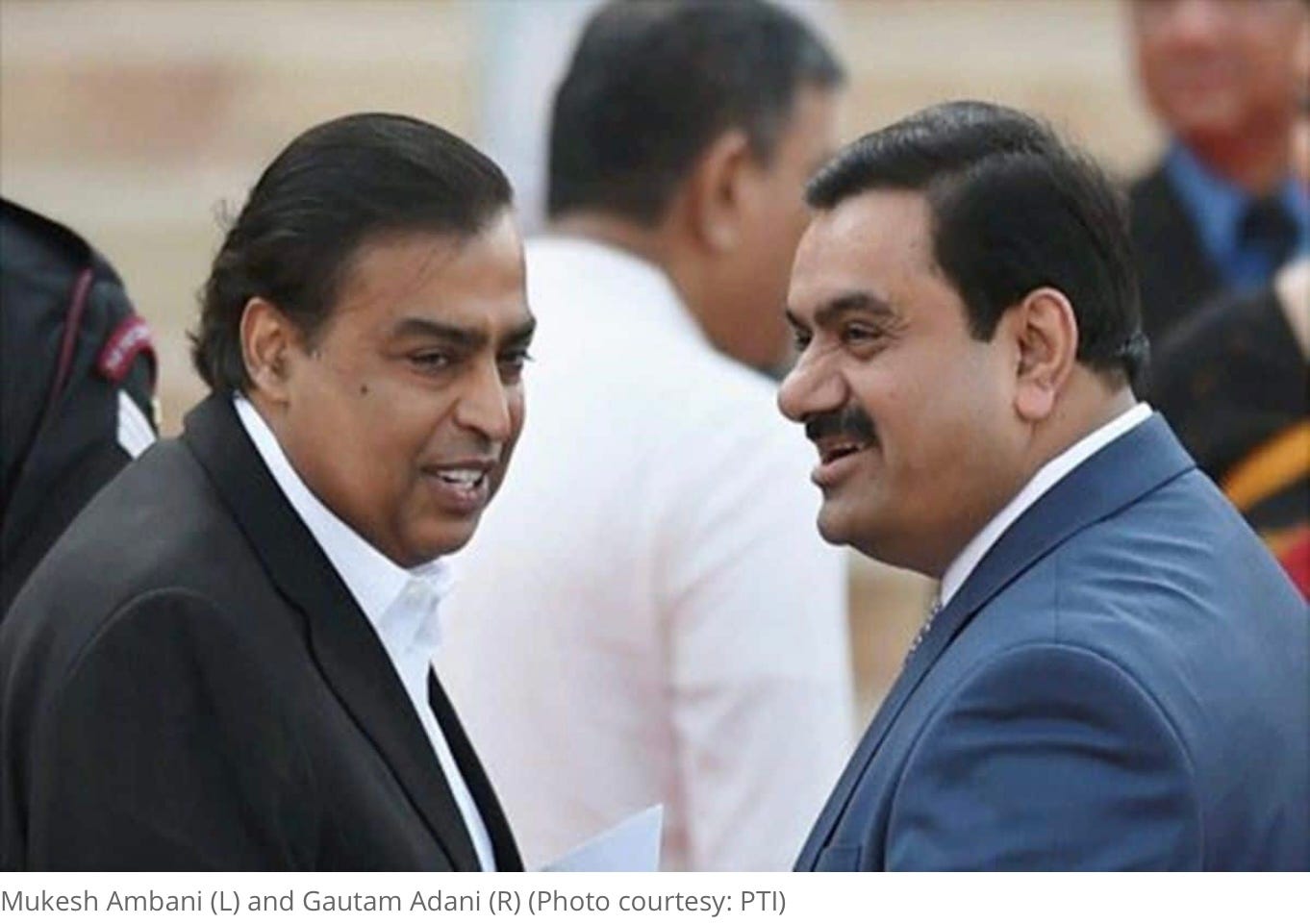You know green energy has arrived in India when the country’s top fossil fuel magnates take the plunge. That’s now happened, with two men who built empires on coal, oil and gas in India suddenly leading the renewables charge.
Is this a good thing? Or, perhaps better put, how good a thing is this?
First came Gautam Adani, who has skyrocketed into the ranks of the world’s richest in lockstep with the rise of Prime Minister Narendra Modi, first in their shared home state of Gujarat and, since 2014, on the national and global stage.
Adani added a renewables energy arm to his coal-ports-and-power empire in 2015, as the Modi government launched a major green energy push. Since then, Adani Green has ballooned into India’s biggest solar energy company.
Now India’s heavyweight of heavyweights, Mukesh Ambani — who cracked the Forbes’ ten richest in the world list this year — has commandeered the bandwagon. Ambani plans to plop down $10 billion over the next three years to make his oil, gas and telco colossus, Reliance Industries, a leader in…well, every aspect of the renewable economy: solar panel manufacturing, solar farms, helping homeowners and small businesses put his solar panels on their rooftops, industrial scale battery production, making electrolyzers to produce hydrogen fuel from water using renewable energy. The $10 billion is almost certainly just a down payment, to be followed by much more investment.
Overstating these guys’ grand ambitions is impossible. They’ve long cannily aligned their interests with Modi. And Modi is very interested in green energy. He’s vowed India will grow renewables ten-fold by 2030, a goal that requires India to more or less add more renewable energy capacity than has been built in the entire country to date each year on average between now and then. Modi’s government is under pressure to show a strong climate commitment — if not unveil a “net-zero” emissions target — going into a major global climate conference this fall. (I wrote about that recently).
India had been building renewable energy capacity at a world-leading pace a few years ago, but progress has bogged down during the Covid crisis. Lockdowns last year, and recently the terrible pandemic wave this spring, have delayed and hamstrung dozens of big projects.
India almost certainly won’t reach Modi’s first goal of installing 175 gigawatts by the end of this year. Analysts and industry officials are already concerned the 450 gigawatt goal could wind up beyond India’s grasp if the project pipeline isn’t turbo-charged soon.
The Adani and Ambani juggernauts have the wherewithal to dramatically re-accelerate renewables in India.
They’re something of an odd duo for the job, to say the least. Both have made fortunes on fossil fuels, often controversially. Adani, whose company is a mainstay provider of electricity from traditional coal generators, has pursued a massive coal mining project in Australia that’s kept him atop climate activists’ villains list for a decade. Ambani built his empire with some of the world’s largest petroleum refineries.
They’ve hardly disavowed fossil fuels — quite the opposite. Adani will finally ship coal from Australia to India this year for the first time — despite activists’ sustained campaign to stop him — and Ambani is cheerfully courting a hefty investment from the largest oil company on the planet, Saudi Arabia’s Aramco.
Yet there’s no denying they get things done. Adani is poised to become one of the largest, if not the largest, renewable energy companies in the world, in part by snapping up flagging competitors’ operations in India’s cut-throat renewables energy business. Troubling though his coal project in Australia may be, there’s no doubting Adani’s determination to push it through with the help of governments on both ends.
In addition to building an oil-and-gas empire, Ambani has revolutionized India’s telecoms industry, an industry where he’d previously had no experience. In 2016, Reliance established a telecommunications arm dubbed Jio. In just two years, Jio built, from scratch, India’s largest mobile phone company. Leveraging massive investments, hyper-aggressive tactics and Ambani’s trademark strategic alignment with the Modi government, Jio completely upended India’s telco market, bringing smartphones and the mobile internet to India’s masses. (That remarkable story told best here by ace Wall Street Journal tech reporter and India hand Newley Purnell.)
Ambani and Adani are all about making money, the case with any mogul worth their weight. They’re masters of working India’s often politicized, highly regulated, government-dominated business landscape, where obtaining capital from state-owned banks and regulatory approvals from government bureaucracies separates the winners from the losers.
If anybody can quickly crank India’s renewables growth back into high gear, it’s these guys, with Modi cheering them on. Green energy fans probably should be clapping, too, as hard as that may be to stomach — and even while continuing to take them to task for their fossil fuel endeavors.
There’s little fakery or greenwashing here. Neither is pretending to disavow fossil fuels or love green energy for its social value. They’re with India’s government: green energy is great, but we need lots of fossil fuel energy, too. Adani and Ambani will mobilize very real, very big bucks to try and make their green energy visions happen. India and the world will benefit from every green electron they produce. Both men, but particularly Ambani, offer one of the world’s best chances to diversify the source of green energy mainstays such as solar panels and batteries beyond China, which utterly dominates manufacturing of the former and close to conquering the latter. Adani already has a solar panel factory up and running; Ambani’s plans both, along with plants to make hydrogen electrolyzers.
That these capable men will continue pushing fossil fuels mightily is a problem, for sure. But perhaps not the biggest one when it comes to their ambitions.
The bigger blow could be to competition in the green energy space. For all the capital these two men can marshal into green energy, it won’t be nearly enough to achieve India’s goals. For that, a garden with a thousand flowers blooming is needed. Two Sequoias won’t be enough.
There are already signs potential and current competitors of Ambani and Adani see the writing on the wall. The French energy super major Total, which is pushing into green energy, earlier this year agreed to buy into Adani Green Energy rather than go it alone in one of the world’s fastest growing renewables markets. Meanwhile, Softbank chucked its once-soaring Indian solar ambitions over to Adani and left the country.
Ambani’s vision outlines few details at this point. But it hints at a strategy that might help small and medium-sized businesses boost home and other small-scale rooftop solar — an area where India’s otherwise impressive renewables story has faltered badly.
That sort of growing the ecosystem will be critical going forward. Two titans, no matter how big, can’t do it alone.






